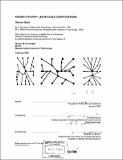Design for very large-scale conversations
Author(s)
Sack, Warren
DownloadFull printable version (22.45Mb)
Other Contributors
Massachusetts Institute of Technology. Dept. of Architecture. Program In Media Arts and Sciences.
Advisor
Kenneth Haase.
Terms of use
Metadata
Show full item recordAbstract
On the Internet there are now very large-scale conversations (VLSCs) in which hundreds, even thousands, of people exchange messages across international borders in daily, many-to-many communications. It is my thesis that VLSC is an emergent communication medium that engenders new social and linguistic connections between people. VLSC poses fundamental challenges to the analytic tools and descriptive methodologies of linguistics and sociology previously developed to understand conversations of a much smaller scale. Consequently, the challenge for software design is this: How can the tools of social science be appropriated and improved upon to create better interfaces for participants and interested observers to understand and critically reflect upon conversation? This dissertation accomplishes two pieces of work. Firstly, the design, implementation, and demonstration of a proof-of-concept, VLSC interface is presented. The Conversation Map system provides a means to explore and question the social and linguistic structure of very large-scale conversations (e.g., Usenet newsgroups). Secondly, the thinking that went into the design of the Conversation Map system is generalized and articulated as an aesthetics, ethics, and epistemology of design for VLSC. The goal of the second, theoretical portion of the thesis is to provide a means to describe the emergent phenomenon of VLSC and a vocabulary for critiquing software designed for VLSC and computer-mediated conversation in general.
Description
Thesis (Ph.D.)--Massachusetts Institute of Technology, School of Architecture and Planning, Program in Media Arts and Sciences, 2000. Includes bibliographical references (leaves 184-200).
Date issued
2000Department
Program in Media Arts and Sciences (Massachusetts Institute of Technology)Publisher
Massachusetts Institute of Technology
Keywords
Architecture. Program In Media Arts and Sciences.